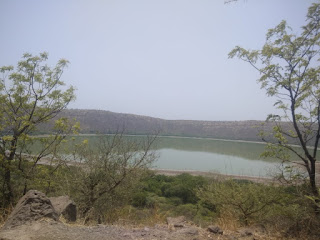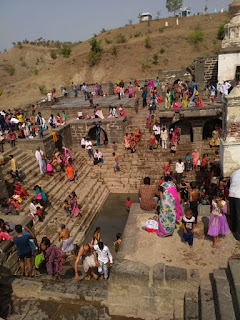Lonar Lake, also known as the Lonar bowl. This Lonar Lake is located in Buldhana District, Maharashtra, India. Lonar Lake has a mean diameter of 1.2 kilometers and is about 137 meters below the crater rim. The meteor crater rim is about 1.8 kilometers in diameter. The water in the lake is both alkaline and saline. Tourist comes to see this natural crater and the nearby peoples are visits with every special occasion. There are so many temples near this lake like -
The area of the lake was declared as Lonar Wildlife Sanctuary by the Government on 20 November 2015. The Lake is a haven for a wide range of plant and animal life. Native and Migrant birds like robins, hoopoes, brahmin duck, etc are found on the lake. At the time of evaporation, the water level is reduced then the large quantity of soda was collected. There are two small streams namely Penganga and Purna sewer into the lake.
Lonar Lake is helpful for those students who studied Ph.D. in Microbiology subjects. There are different types of microorganisms are available on the border of the lake such as :
Methylotrophic microorganisms
Endolithic microorganisms
Nitrogen-fixing microorganisms
Lonar Lake appears green for most of the year due to the presence of heavy blooms of cyanobacteria.
Visit the Lonar Lake once in life and see the nature which is around it.
 |
| Lonar Lake |
- Kamalja Devi Temple is located beside the lake. Although the water level rises during the rainy season and falls in summer, the temple is located above the water level. At the time of Navratri, there is a huge crowd of people with their devotedness.
- Gomukh Temple is located along the edge of the crater. The continuing stream of water, visitors taking a bath in this undying stream.
- Shankar Ganesh temple.
- Ram Gaya temple.
- Motha Maruti temple is near the Ambar crater lake.
 |
| Kamalja Devi Temple |
Hazards to Lonar Lake
Lonar Lake faces environmental problems like : |
| Gomukh Temple |
- During local festivals such as the Navratri, large numbers of visitors, enter the hollow. Small shops and food-stalls are often established near the hollow or along with its border.
- Profitable activities, including unauthorized construction, within the local area of the lake, has damaged the lake's natural area.
- Continuing streams are one of the water sources for the lake. Those streams are used for bathing, washing clothes and cattle, and other domestic purposes by the local people, visitors, and tourists.
- Fertilizers, pesticides, and toxic materials are used in the agriculture field around the lake results in the pollution of lake water.
- The government is unable to raise funds needed for preserving this hollow and often tourist activities continue to cause environmental damage to nearby land.
The area of the lake was declared as Lonar Wildlife Sanctuary by the Government on 20 November 2015. The Lake is a haven for a wide range of plant and animal life. Native and Migrant birds like robins, hoopoes, brahmin duck, etc are found on the lake. At the time of evaporation, the water level is reduced then the large quantity of soda was collected. There are two small streams namely Penganga and Purna sewer into the lake.
Lonar Lake is helpful for those students who studied Ph.D. in Microbiology subjects. There are different types of microorganisms are available on the border of the lake such as :
Methylotrophic microorganisms
Endolithic microorganisms
Nitrogen-fixing microorganisms
Lonar Lake appears green for most of the year due to the presence of heavy blooms of cyanobacteria.
Visit the Lonar Lake once in life and see the nature which is around it.


